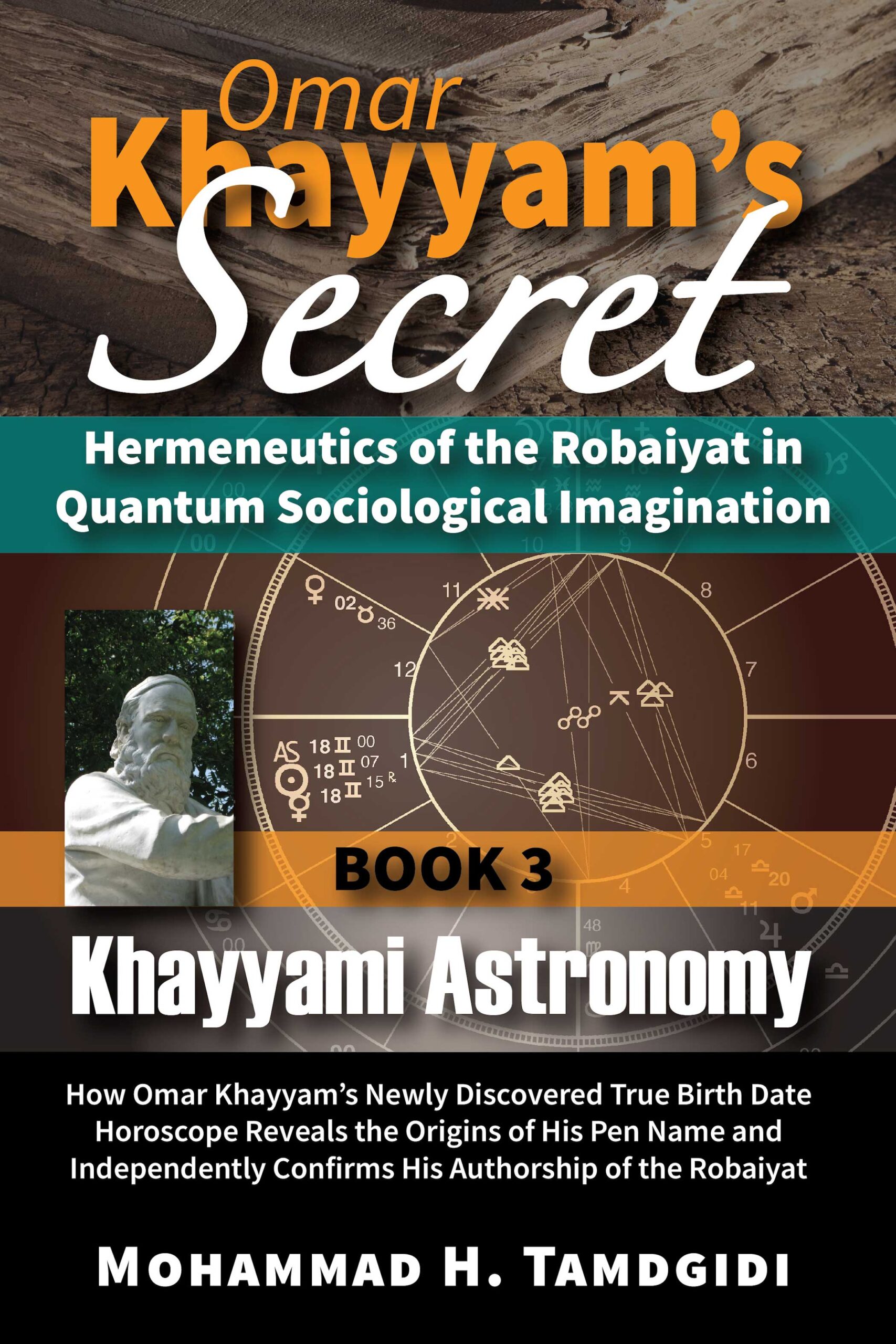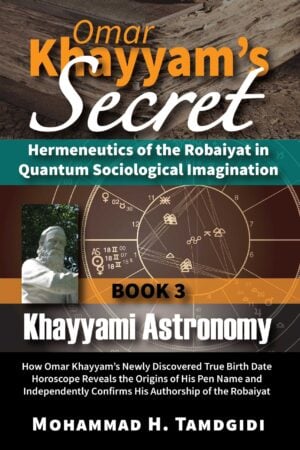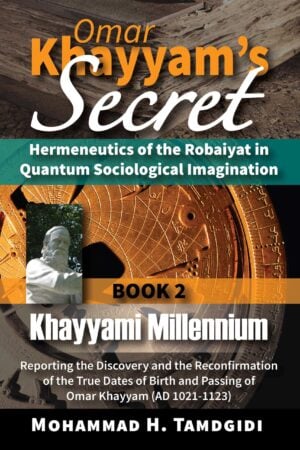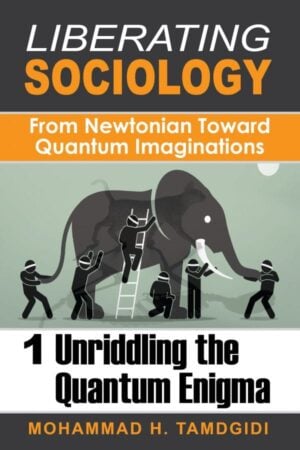Book Section: CHAPTER III — Features of Omar Khayyam’s Horoscope as a Whole Based on Astrological House and Other Definitions Traditionally Held in His Own Time — by Mohammad H. Tamdgidi
$20.00
This essay, titled “Features of Omar Khayyam’s Horoscope as a Whole Based on Astrological House and Other Definitions Traditionally Held in His Own Time,” is the third chapter of the book Khayyami Astronomy: How the Newly Discovered True Birth Horoscope of Omar Khayyam Reveals the Origins of His Pen Name and Independently Confirms His Authorship of the Robaiyat, which is the third volume of the twelve-book series Omar Khayyam’s Secret: Hermeneutics of the Robaiyat in Quantum Sociological Imagination, authored by Mohammad H. Tamdgidi.
Description
Abstract
This essay, titled “Features of Omar Khayyam’s Horoscope as a Whole Based on Astrological House and Other Definitions Traditionally Held in His Own Time,” is the third chapter of the book Khayyami Astronomy: How the Newly Discovered True Birth Horoscope of Omar Khayyam Reveals the Origins of His Pen Name and Independently Confirms His Authorship of the Robaiyat, which is the third volume of the twelve-book series Omar Khayyam’s Secret: Hermeneutics of the Robaiyat in Quantum Sociological Imagination, authored by Mohammad H. Tamdgidi.
In Table III.1 presented at the beginning of the chapter, Tamdgidi provides an important and central heuristic device for furthering the purpose of the hermeneutic analysis in third and following chapters as a whole.
In the interpretive effort in this chapter and the next on the basis of that table, the author draws on a recently discovered and published work in Iran by a contemporary of Khayyam, Shahmardan Razi, titled Rowzat ol-Monajjemeen (روضة المنجّمين) (Garden of Astrologers) written in AD 1072/466 LH. He also consulted a book on astrology written by another near-contemporary of Khayyam, Abu Rayhan Biruni, originally titled Interpretation (تفهيم) and written in AD 1029, published in English translation as Al-Biruni: The Book of Instruction in the Elements of the Art of Astrology (1934, rep. 2016).
Other sources have also been consulted such as those by Astrodienst (astro.com), while also having found the differences between medieval and modern astrology as discussed in Medieval Astrology Guide (medievalastrologyguide.com) helpful.
According to Tamdgidi, since this book aims at conducting its hermeneutic analysis within a traditional/medieval (not modern) astrological environment, details that follow, as also partly given in the Table III.1 that is introduced in the chapter, are intended to fall within that system of interpretation as cross-checked with the definitions given in the above two main works by Razi and Biruni.
The reason Tamdgidi makes an intervention in the definitional structures of astrology as practiced today is that a hermeneutic study of Khayyam’s horoscope obviously depends inescapably on what meaning we assign to the ordering of houses, and where they come from. It just happens that in his efforts in making sense of Khayyam’s horoscope, he had to clarify this question for himself by consulting Razi’s book that casts a helpful light on the matter, one that, besides being of help in this study of Khayyam’s natal chart, may as well be generally helpful to astrology studies for understanding the historical and conceptual origins of the house system.
The main reason for Tamdgidi’s highlighting Razi and Biruni is to make sure to keep in mind the hermeneutic purpose of the analysis carried out in this chapter and the next (and this book as a whole). Today’s astrologers may have good (or not) reasons to define the houses in their own ways, but the point of this study is to ask, to the extent realistically possible, what definitional system Khayyam himself would have used in trying to figure out the meaning of his natal chart. The author emphasizes that we are not trying in this book to offer an astrological analysis of Khayyam’s chart per se; rather, we are interested in understanding how Khayyam himself would have interpreted his own chart. And toward that end, it is of course crucial to have a sense of how the houses were defined at the time he lived.
Again, Tamdgidi wishes to draw the reader’s attention to the fact that our interest in astrological systems and schemes in this book and series are hermeneutic. We are studying the life and works of not just anybody, but of Omar Khayyam, who was a master astronomer and expert in matters astrological as well, whether he fully, partly, or differently believed in them, or not. We are interested in hermeneutically putting ourselves in his shoes, so to speak, and consider astronomical and astrological factors, because we have no doubt that he was fully versed and learned in them and must have considered them.
Beside the definition of houses, there are several other aspects of Razi’s contribution that the author finds noteworthy and reaffirming for what he finds needing to be considered in the hermeneutic astrological interpretation of Khayyam’s natal chart, such as approaches to orbs, Cazimi, interpretations of Jupiter in relation to other planets, wider interplanetary relations, house rulers, matters of gender, Firdaria, observations of the ascendant, and a few other features on which the author also comments in this chapter.
Tamdgidi also offers comments on both the significant limitations and a few possible contributions modern computerized astrological interpretive tools can make in the hermeneutic analysis of Khayyam’s birth chart that is advanced in this chapter and the one to follow.
Recommended Citation
Tamdgidi, Mohammad H. 2021. “CHAPTER III — Features of Omar Khayyam’s Horoscope as a Whole Based on Astrological House and Other Definitions Traditionally Held in His Own Time.” Pp. 89-130 in Omar Khayyam’s Secret: Hermeneutics of the Robaiyat in Quantum Sociological Imagination: Book 3: Khayyami Astronomy: How Omar Khayyam’s Newly Discovered True Birth Date Horoscope Reveals the Origins of His Pen Name and Independently Confirms His Authorship of the Robaiyat. (Human Architecture: Journal of the Sociology of Self-Knowledge: Vol. XVI, 2021. Tayyebeh Series in East-West Research and Translation.) Belmont, MA: Okcir Press.
Where to Purchase Complete Book: The various editions of the volume of which this Book Section is a part can be ordered from the Okcir Store and all major online bookstores worldwide (such as Amazon, Barnes&Noble, Google Play, and others).
Read the Above Publication Online
To read the above publication online, you need to be logged in as an OKCIR Library member with a valid access. In that case just click on the large PDF icon below to access the publication. Make sure you refresh your browser page after logging in.








